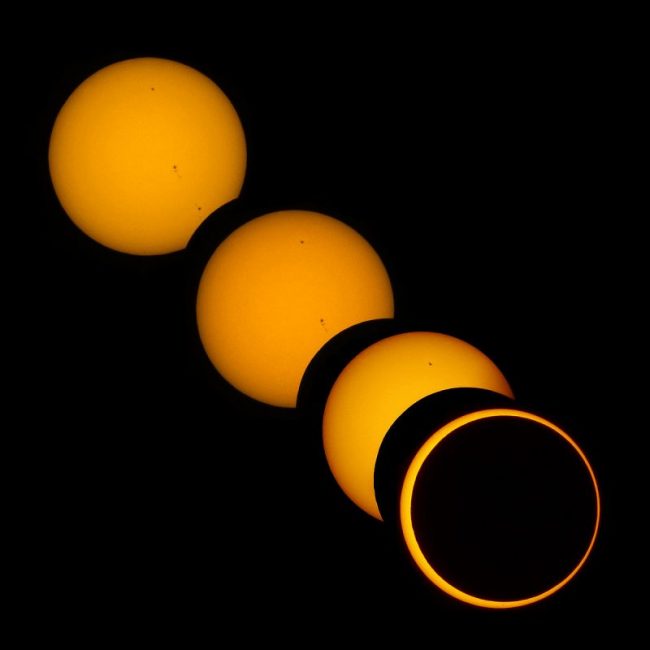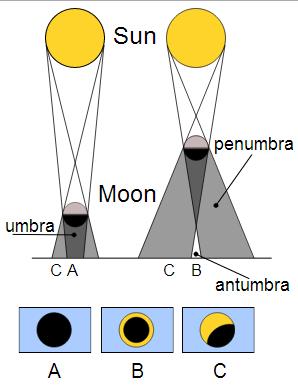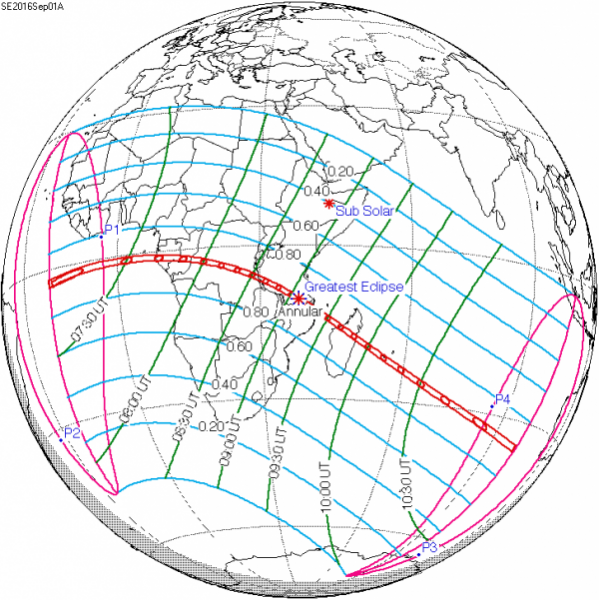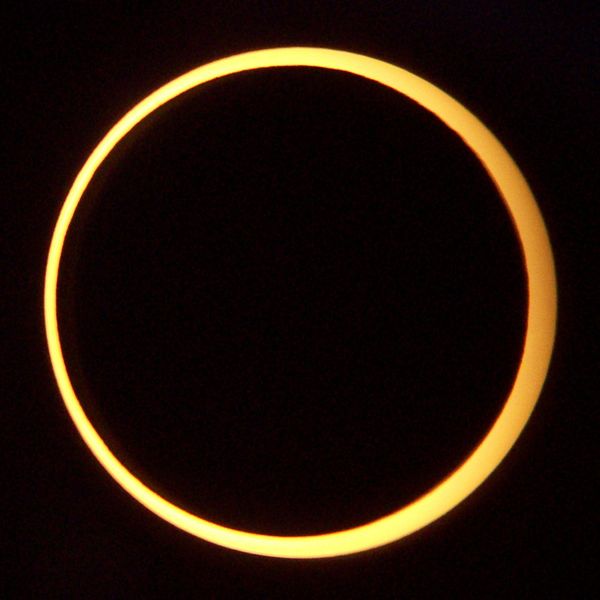As seen from the southern tropical regions of Africa and Madagascar, the new moon will pass directly in front of the solar disk on September 1, 2016, to stage an annular eclipse of the sun. Nowadays, people call these sorts of eclipses ring of fire eclipses … although the ring around the sun is not actual fire but something vastly hotter, the surface of the sun itself.
During a ring of fire eclipse, the moon lies too far away from Earth to completely cover over the sun’s disk, so a thin ring – or annulus – of sunlight surrounds the new moon silhouette, as seen in the images above and below. Hence annular solar eclipse.
This is the second and final solar eclipse of 2016.
Observing solar eclipses safely


During the previous solar eclipse on March 9, 2016, the new moon came closer to Earth and loomed larger in Earth’s sky. Therefore, the moon completely covered over the sun’s face, to showcase a total eclipse of the sun in March 2016.
Annular solar eclipses are slightly more common than total solar eclipses. For instance, 224 solar eclipses occur in the 21st century (2001 to 2100), of which 68 are total, 72 are annular and 77 are partial.
The next total solar eclipse will occur in the United States on August 21, 2017. Hotel rooms are filling up along the eclipse path, so make your plans now!
The video below – from the beautiful website shadowandsubstance.com by Larry Koehn shows the path of the September 1, 2016 annular solar eclipse.
Annular Eclipse of the Sun Over Africa On September 1, 2016 from LarryKoehn on Vimeo.
The thin red ribbon crossing the Earth on the map below also depicts the approximate 13,400-kilometer (8,330-mile) path of the annular solar eclipse.
The annular eclipse starts at sunrise in the Atlantic Ocean to the west (left) of Africa, crosses Africa from west to east (left to right) and ends at sunset over the Indian Ocean some 3.6 hours later. The greatest eclipse happens at noon near the east coast of Africa (Tanzania).
Although, on a worldwide scale, the annular eclipse from start to finish lasts about 3.6 hours, any point along the central track of the annular eclipse has a rather short-lived annular eclipse, with an approximate duration of 3 minutes.
A partial solar eclipse precedes and follows the annular eclipse, meaning the whole eclipse at any point along the central eclipse path lasts for several hours.
Observing solar eclipses safely

From a much wider swath of the world, varying degrees of a partial solar eclipse can be seen to the north and to the south of the path of annularity. Note the numbers 0.80, 0.60, 0.40, 0.20 and 0.10 above and below the annular eclipse path. These numbers refer to the eclipse magnitude – the fraction of the sun’s diameter that is covered over by the moon.
We refer you to the Google Map of the annular solar eclipse, enabling you to find out when the eclipse starts and ends at any spot within the eclipse viewing area. However, the time is given in Universal Time. Click here to translate Universal Time to local time.

Eclipse calculators
In addition to the Google map, you can use the eclipse calculators below to know if the eclipse is taking place in your part of the world; and if so, at what times. If you have difficulty converting Universal Time to your local time, try TimeandDate.com, which gives the eclipse times in local time.
Solar eclipse calculator in local time via TimeandDate.com
Solar eclipse computer in Universal Time via US Naval Observatory in Universal Time
Bottom line: The annular eclipse of the sun on September 1, 2016, is primarily visible from Africa and Madagascar.












